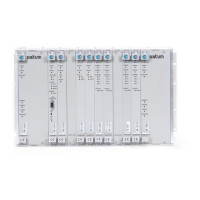12713020-003-2 Revision F.01 – January 2007 SSU-2000 Technical Reference 31
Chapter 2 TL1 Reference
TL1 Command and Response Conventions
*C= critical alarm
** = major alarm
*^ = minor alarm
A^= non-alarm event
atag (Alarm Correlation Tag) is a six-digit correlation tag that is incremented
each time a message is sent
REPT (Report) indicates an autonomous report
AIDTYPE indicates the cause for the report, such as input signal fault (INP or T1)
or module hardware faults (EQPT)
"response message" is the response message. The format for the response
message line is:
^^^"[aid]:ntfcncde,condtype,srveff,ocrdat,ocrtm[:condscr]" <cr lf>
where:
–
ntfcncde (Notification Code) is an optional field that further describes the
alarm or event in an output response or autonomous report, if required.
The notification code is one of these two-character codes:
CR Critical alarm;
MJ Major alarm;
MN Minor alarm:
CL Cleared alarm;
NA Event (not an alarm)
–
condtype (Condition Type) indicates the type of alarm or event that the
message is reporting
–
srveff (Service Affecting or Not Service Affecting) indicates whether the
response message affects service: SA (Service Affecting response) or
NSA (Not Service Affecting response)
–
ocrdat (Occurrence Date) indicates the date of occurrence in the format
YY-MM-DD (year, month, day)
–
ocrtm (Occurrence Time) indicates the time of the occurrence in the
format HH:MM:SS (hours, minutes, seconds)
–
condscr (Condition Description) is an optional text string which is sent
with the alarm or event and which indicates the alarm or event condition
The GR-833 format for an autonomous alarm report is:
<cr lf lf>
^^^sid^date^time <cr lf>
alrmcde^atag^REPT^ALM^[AIDTYPE]<cr lf>
^^^"aid:ntfcncde,condtype,srveff,ocrdat,ocrtm:condscr"<cr lf>
where the terms are identified in this section.
The GR-833 format for an autonomous event report is:

